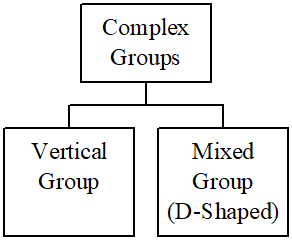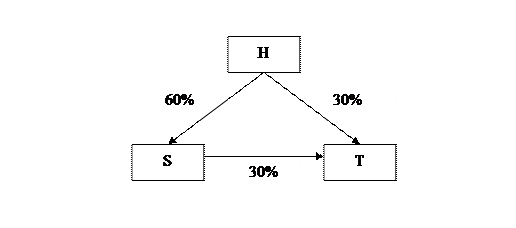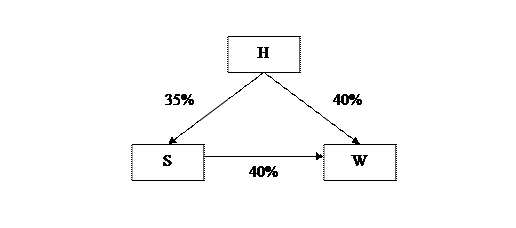Chapter 12 Complex Groups
LEARNING OBJECTIVES 1. Apply the method of accounting for business combinations, including complex group structures (vertical and D-shaped/mixed groups). |

1. Vertical Groups
1.1 Effective shareholdings
1.1.1 A vertical group arises where a subsidiary of the parent entity holds shares in a further entity such that control is achieved. The parent entity therefore controls both the subsidiary entity and, in turn, its subsidiary (often referred to as a sub-subsidiary entity). Look at the two situations:
Situation 1: |
Situation 2: |
|
|
In situation 1, H has an effective interest of only 72% (90% × 80%) in S2. Nevertheless, S2 is a sub-subsidiary of H because H has a controlling interest in S1 and S1 has a controlling interest in S2. As H has an effective interest in S2 of 72%, it follows that the non-controlling interest in S2 is 28%. This can be analysed as follows:
|
% |
Owned by outside shareholders in T |
20 |
Owned by outside shareholders in H [(100% – 90%) × 80%] |
8 |
Effective NCI in S2 |
28 |
In situation 2, H has an effective interest of just 42% (70% × 60%) in S2. Nevertheless, S2 is a sub-subsidiary of H because H has a controlling interest in S1 and S1 has a controlling interest in S2. As H has an effective interest in S2 of 42%, it follows that the non-controlling interest in S2 is 58%. This can be analysed as follows:
|
% |
Owned by outside shareholders in T |
40 |
Owned by outside shareholders in H [(100% – 70%) × 60%] |
18 |
Effective NCI in S2 |
58 |
1.2 Group reserve
1.2.1 Only the group or effective percentage of each of the reserves of the sub-subsidiary are included within group reserves. Often the only reserve will be retained earnings, but there could be others, such as revaluation reserve.
1.3 Date of acquisition
1.3.1 The date of acquisition of each subsidiary is the date on which H gains control. If S1 already held S2 when H acquired S1, treat S1 and S2 as being acquired on the same day.
1.3.2 Consider the following situations to determine when the sub-subsidiary company, S2, becomes a member of the H group:
(a) H acquired control of S1 on 1 January 2004; S1 subsequently acquired control of another entity, S2, on 1 July 2006.
In this situation, S2 does not come under the control of H until S1 acquire shares in S2 – i.e. on 1 July 2006.
(b) H acquired control of S1 on 1 July 2006; S1 had already acquired control of another entity, S2, on 1 January 2004.
Similarly, H cannot gain control of S2 until S1 acquires shares in S2 on 1 July 2006.
1.3.3 |
Example 1 – Full goodwill method |
|||||||||||||||||||||||||||||||||||||||||||||||||||||||||||||||||||||||||||||||||||||||||||||||||||||||||||||||||||||||||||||||||||||||||||||||||||||||||||||||||||||||||||||||||||||
|
The draft statements of financial position of D, C and J, as at 31 December 2012, are as follows:
You ascertain the following: Required: Produce the consolidated statement of financial position of the D group at 31 December 2012. It is group policy to use the full goodwill method. Solution: W1 Group structure
W2 Net assets of subsidiaries at acquisition date
W3 Goodwill
W4 Group retained earnings
Note that again, only the group or effective interest of 60% is taken of the post-acquisition retained earnings of J.
W5 Non-controlling interest
Consolidated statement of financial position as at 31 December 2012
|
1.3.4 |
Example 2 – Proportion of net assets method |
|||||||||||||||||||||||||||||||||||||||||||||||||||||||||||||||||||||||||||||||||||||||||||||||||||||||||||||||||||||||||||||||||||||||||||||||||||||||||||||||||||||||
|
The draft statements of financial position of D, C and J, as at 31 December 2012, are as follows:
You ascertain the following: It is group policy to value the non-controlling interest using the proportion of net assets method. Required: Produce the consolidated statement of financial position of the D group at 31 December 2012. It is group policy to use the full goodwill method. Solution: W1 Group structure
W2 Net assets of subsidiaries at acquisition date
W3 Goodwill
W4 Group retained earnings
W5 Non-controlling interest
Consolidated statement of financial position as at 31 December 2012
|
2. Mixed (D-shaped) Groups
2.1 Definition
2.1.1 In a mixed group situation the parent entity has a direct controlling interest in at least one subsidiary. In addition, the parent entity and the subsidiary together hold a controlling interest in a further entity.


H controls 60% of S; S is therefore a subsidiary of H.
H controls 30% of T directly and another 30% indirectly via its interest in S. T is therefore a sub-subsidiary of the H group.
2.2 Date of acquisition
2.2.1 Suppose H acquired a 60% interest in S on 1 January 2012, and acquired its 30% interest on the same date. S subsequently acquired its 30% interest in T on 1 July 2012.
Initially, from 1 January 2012, H exercises significant influence over T as an associate entity. It is only from 1 July 2012 that H has access to more than 50% of the voting power in T; T is therefore consolidated into the H group accounts as a subsidiary from 1 July 2012.
Alternatively, suppose H acquired 60% interest in S on 1 January 2012, and acquired its 30% interest in T on the same date. S acquired its 30% interest in T on 1 July 2012.
Initially, from 1 January 2012, S exercises significant influence over T as an associate entity. It is only from 1 July 2012 that H has access to more than 50% of the voting power in T; T is therefore consolidated into the H group accounts from 1 July 2012.
2.2.2 Note that the definition of a mixed group does not include the situation where the parent and an associate together hold a controlling interest in a further entity. For example:
H owns 35% of S, S owns 40% of W and H owns 40% of W.


This is not a mixed group situation. Neither S nor W is a member of the H group, although S and W may both be ‘associates’ of H.
H’s interest in W might be calculated as before as (35% × 40%) + 40% = 54%. Although H has an arithmetic interest in W that is more than 50%, it does not have parent entity control of W, as it does not control S’s 40% stake in W.
2.3 Consolidation
2.3.1 The approach is similar to deal with sub-subsidiaries, i.e. an effective interest is computed and used to allocate share capital and retained earnings.
2.3.2 All consolidation workings are the same as those used in vertical group situations, with the exception of goodwill.
2.3.3 The goodwill calculation for the sub-subsidiary differs in that two elements to cost must be considered, namely:
(a) the cost of the parent’s direct holding,
(b) the parent’s percentage of the cost of the subsidiary’s holding (the indirect holding).
2.3.4 |
Example 3 |
||||||||||||||||||||||||||||||||||||||||||||||||||||||||||||||||||||||||||||||||||||||||||||||||||||||||||||||||||||||||||||||||||||||||||||||||||||||||||||||||||||||||||||||||||||||||||||||||||||||||||||||||||||||||||
|
The statements of financial position of H, S and M, as at 31 December 2012, are as follows:
All shares were acquired on 31 December 2009 when the retained earnings of S amounted to $30,000 and those of M amounted to $10,000. It is group policy to value the non-controlling interest on a proportionate basis. Required: Prepare the consolidated statement of financial position of the H group at 31 December 2012. Solution: W1 Group structure
W2 Net assets of subsidiaries at acquisition date
W3 Goodwill
W4 Group retained earnings
W5 Non-controlling interest
Consolidated statement of financial position as at 31 December 2012
|
Question 3
On 1 January 2011, S acquired 35,000 ordinary shares in R at a cost of $65,000 when the retained earnings of R amounted to $40,000. On 1 January 2012, T acquired 64,000 shares in S at a cost of $120,000 and 40,000 shares in R at a cost 80,000. The retained earnings of S and R amounted to $50,000 and $60,000 respectively on 1 January 2012. The fair value of the NCI is S at that date was $27,000. The fair value of the whole (direct and indirect) NCI in R was $56,000. The NCI is measured using the full goodwill method. At the reporting date, goodwill has not been impaired. Required: Prepare the consolidated statement of financial position of the T group as at 31 December 2012. |
Source: http://hkiaatevening.yolasite.com/resources/P2CRNotes/Ch12-ComplexGroups.doc
Web site to visit: http://hkiaatevening.yolasite.com/
Author of the text: indicated on the source document of the above text
If you are the author of the text above and you not agree to share your knowledge for teaching, research, scholarship (for fair use as indicated in the United States copyrigh low) please send us an e-mail and we will remove your text quickly. Fair use is a limitation and exception to the exclusive right granted by copyright law to the author of a creative work. In United States copyright law, fair use is a doctrine that permits limited use of copyrighted material without acquiring permission from the rights holders. Examples of fair use include commentary, search engines, criticism, news reporting, research, teaching, library archiving and scholarship. It provides for the legal, unlicensed citation or incorporation of copyrighted material in another author's work under a four-factor balancing test. (source: http://en.wikipedia.org/wiki/Fair_use)
The information of medicine and health contained in the site are of a general nature and purpose which is purely informative and for this reason may not replace in any case, the council of a doctor or a qualified entity legally to the profession.
The texts are the property of their respective authors and we thank them for giving us the opportunity to share for free to students, teachers and users of the Web their texts will used only for illustrative educational and scientific purposes only.
All the information in our site are given for nonprofit educational purposes